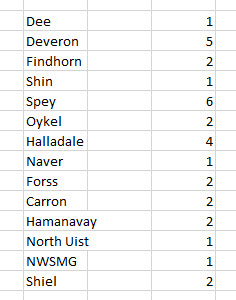Seal the deal: There has been much written about salmon farming and seals since the Scottish Government announced a ban on the killing of seals by salmon farms. According to the Daily Telegraph, almost 950 seals were legally shot in Scotland between 2011 and 2019 with fish farms licensed to kill the animals to prevent them from attacking and eating salmon in the farm cages. The Telegraph say that the ban will ensure that Scottish farmed salmon can continue to be exported to the United States. The US requires all nations exporting fish to have marine protection measures similar to its own in place.
The Scottish charity OneKind says that the number of seal deaths has increased with a total of 97 seals shot in 2019 compared to 2018. They also express concern that seal shooting increased in the first quarter of 2020 with 32 seals shot, all but one of them shot at fish farms.
I will repeat that – ‘All but one of them shot at fish farms.’
OneKind mean that people other than salmon farmers might be shooting seals, but this is rarely discussed in the press. The focus is always on salmon farming as can be seen by the following tweet from Seal Scotland (Selkie – seal):

Whilst OneKind imply that 97 seal deaths in 2019 are associated with salmon farms, the truth is that salmon farms were responsible for 65 of the seal deaths. The other 32 seals were shot by wild salmon interests. In the past, much of the blame on seal shooting has been directed towards commercial netsmen, as highlighted in the recent movie ‘Of Fish and Foe’. However, it can be seen by the following list, that many of the licence holders in 2019, were salmon fishery boards:
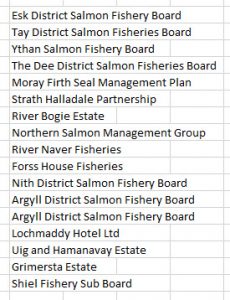
However, not all of these licence holders used their license to shoot a seal in 2019. The list of seals shot by such wild fish interests can be seen in the following table:
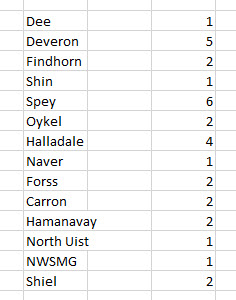
It is understandable that salmon farmers might want to kill a seal if it penetrates the nets and attempts to access the fish but it is unclear exactly how the threat to wild fish would be assessed that would prompt a seal to be shot in a natural river system.
Meanwhile, The Daily Telegraph reported that Mark Ruskell, MSP and environmental spokesman for the Scottish Greens said that ‘The Scottish Government has been under enormous pressure for years to act on the wholesale slaughter of seals by industrial-scale fish farming’. Clearly, either Mr Ruskell is ignorant about seal shooting by others or he is so focused on his campaign against salmon farming that only shooting by salmon farmers is of interest to him. Whichever it is, he never responds to any enquiry to clarify such issues.
Regular readers might remember that at the start of 2019, I wrote about a group of sea lions living near the Williamette Falls south of Portland in Oregon. These sea lions were helping themselves to a fragile population of trout from the Williamette River. Local fishery managers had tried to relocate the most problematic of the sea lions but they all found their way back to the river. Consequently, the state ‘Department of Fish and Wildlife’ obtained a federal license to kill up to 93 sea lions annually.
By the start of 2019, 150 animals had also been killed in a similar programme protecting fish stocks below the Bonneville Dam on the Columbia River. It is unclear whether these programmes to eliminate problematic sea lions continues to date.
Just this week, the Tyee, a Canadian online magazine based in Vancouver highlighted a potential conflict between Canada and the US on the status of some coastal whale populations. About 27,000 North Pacific Grey whales migrate each year from the coast of Mexico to Alaska to feed. However, about 250 individuals skip the full migration each year and spend the summer around the US-Canada border off the coast of Seattle and Vancouver.
The US side of the border is home to the Makah Tribe based in Neah Bay who are the only tribe in the US with an explicit treaty right to hunt whales. They legally killed one whale in 1999 and another illegally in 2007. However, they have now applied to hunt 25 whales over the next ten years. Their application is supported by the US National Marine Fisheries Service, a branch of the National Oceanic and Atmospheric Administration (NOAA), which has asked an administrative law judge for a waiver to the Marine Mammals Protection Act.
Meanwhile, in Canada, the Committee on the Status of Endangered Wildlife in Canada has recommended to the environment minister that the Pacific group of Grey Whales should be designated as endangered under the Species at Risk Act.
This could mean that whales, protected in Canadian waters could be hunted just across the border. This is an ongoing battle but what is clear is that the legislation that will ban seal shooting in Scotland can be interpreted very differently in the US.
Afterword: The Scottish Parliament debated the new wildlife legislation on Wednesday and the outcome is that salmon farmers will no longer be able to apply for a licence to shoot seals and without a licence then no seals can be shot. However, various reports suggest that wild fish interests may still be able to continue shooting seals to protect their fisheries.
This is a real puzzle since if it is deemed cruel to kill seals to protect farmed salmon why is it not cruel to kill a seal to protect wild fish? Of course, the answer is that most of those campaigning to end seal killing by salmon farmers don’t really care about seals at all. They are only interested in causing as much damage to the salmon farming industry as they can. For them, it’s all about salmon farming. Even the welfare charities have been carried along by the anti-salmon farming sentiments. This is why OneKind partnered with Salmon & Trout Conservation even though their communications consultant clearly stated on a podcast that salmon angling is inherently cruel.
If wild fish interests can continue to shoot seals what impact would that have on farmed salmon exports. It makes no sense that the US will restrict imports if seals have been harmed during production but will allow imports if Scottish seals are still killed but not as part of the production process.
Finally, one MSP asked what guidance farmers would be given if seals managed to penetrate even the most robust nets and ended up in the pen with the salmon. Perhaps, the Scottish Government might also apply a waiver as long as video evidence is retrospectively submitted.
NASCO: The North Atlantic Salmon Conservation Organisation (NASCO) held its 37th Annual Meeting during the first week of June. The meeting took place by video link and this is perhaps why it passed unnoticed except by those who participated. One of those who attended was Paul Knight, soon to retire as head of Salmon & Trout Conservation and it is through his commentary that news of the meeting was publicised.
Mr Knight has been very keen to pass on news of the meeting because as he writes, the main objective of the attending NGOs, including Salmon & Trout Conservation, was to garner support for a full day ‘Theme -based Special Session’ (TBSS) on salmon farming at next year’s annual meeting. Mr Knight says that this is because of increasing concern across the North Atlantic that open net salmon farming is the most damaging issue for wild salmon and sea trout that NASCO parties actually have the power to do something about.
It is this view that illustrates the completely blinkered thinking of parts of the wild fish sector. It is nonsense that the NGOs should force NASCO to spend a whole day discussing an issue that probably impacts one to two percent of wild salmon, only because it is something they think they can act on. What they want is to persuade certain jurisdictions, such as Scotland, to impose even greater controls on the salmon farming industry, despite the fact that this is unlikely to reverse the declines of wild salmon stocks. Surely it would make much more sense to take advantage of the presence of all the national delegates to hold a TBSS on issues like the ever-increasing mortality of wild salmon at sea. Together as a group, NASCO delegates might be able to arrive at some form of answer to marine mortality upon which they can act. If they fail to discuss such issues, how can they ever reach any conclusion? It could well be an answer might be forthcoming but if they just endlessly discuss the impacts of salmon farming how will they ever know?
Sadly, Mr Knight and his colleague in Scotland, Andrew Graham Stewart are so blinkered to anything but salmon farming that they are going to be greatly disappointed if and when they find any increased measures against the industry do nothing to help safeguard wild salmon stocks.
I can only repeat that if Mr Knight and Mr Graham Stewart are so passionate about safeguarding wild salmon, why then are they only willing to discuss the issues with people that agree with them. They are certainly not prepared to face those who have a different view. I have sent both the link to my Loch Maree video and asked for their views, but as yet a total wall of silence. I find this puzzling since sooner or later someone in authority will undoubtedly ask them to defend their position. Their reluctance to do so now only delays the inevitable. If they are so convinced about their position, they will have no difficulty in explaining why my interpretation of the events in Loch Maree is wrong.
However, the one aspect of Mr Knight’s commentary that is of most concern is that that he said that he was delighted that the NGOs received unanimous support from all the ‘Heads of Delegation’ for a TBSS to take place in twelve month’s time. The delegations come from a wide range of countries, including Scotland, and thus the Scottish delegation must have also given their support to the TBSS too.
I don’t know who headed the Scottish delegation at this meeting but previously, it has been someone from Marine Scotland. Given that the wild fish and farming sectors have recently invested eighteen months working with Marine Scotland to arrive at an agreement about salmon farming through the Salmon Interactions Working Group it seems strange that the Scottish delegation would want to fan the flames between the farming and wild sectors.
In the past, NASCO have always appeared reluctant to allow speakers from the salmon farming sector to address their meetings. I have put my name forward to be a speaker at this proposed TBSS meeting. I would imagine that the programme has not yet been discussed so that excuse as to why I cannot speak can be dismissed. Surely, the TBSS must be considered a pointless exercise if it doesn’t include both sides of the debate. There is absolutely no point in the same NGOs just repeating the same points over and over again in an attempt to avoid facing the issues that don’t suit their narrative.
What’s the catch?: Although there is a general unwillingness to discuss the issues I have raised, about salmon interactions, one recurring message I hear is that the catch data I use is considered unreliable. However, there is only one reason why the catch data for wild salmon and sea trout would be considered unreliable and that is because it hasn’t been recorded accurately by the wild fish sector itself.
I mention this because this week, the Tweedbeats on-line column stated that after previous messages expressing hope that anglers would not kill any of the precious Tweed salmon they catch, one correspondent indicated that many more salmon are killed on the Tweed than are reported. Not only that, but the methods of fishing are not always as pure and legal as they should be on some well-known beats. The correspondent suggests that backs are turned to please visiting anglers as well as to augment the number of tips received by the ghillies.
The Tweedbeats column states that undoubtedly some of this is true and that every barrel has a few bad apples. The column continues that fortunately most ghillies and boatmen operate in the river’s best interests and that fishermen should be thankful and grateful.
The column expresses hope that any bad apples are exposed for what they are and the sooner the better.
However, the underlying point is that what happens on the Tweed could happen on any salmon river in Scotland and that any unreported fish could dramatically affect the overall catch data and hence any future strategies for safeguarding stocks. Perhaps the wild fish sector needs to get their own house in order before placing demands on the salmon farming industry.
With regard to the data I use, I believe that long-term data series even out any discrepancies but now that stocks are under increased pressure, the collection of accurate data is essential.
KFC: I have yet to hear any calls for the public to stop eating chicken from KFC. This follows the news that 58 staff at the 2 Sisters chicken processing plant in North Wales have been found to test positive for Covid. A further 22 members of staff are self isolating. Despite a high number of staff found to have the virus, there is no suggestion that the chicken is not safe to eat.
In Germany, 200 workers at a meat processor have been found to have contracted the virus. There are no suggestions that the meat is not safe to eat.
Yet, when the virus was found on the surface of a chopping board on which salmon had been filleted, there have been a whole host of claims that salmon has spread the virus. These claims have now been debunked as nonsense.
This is not surprising since most of the claims made about salmon farming are just as nonsensical but sadly, the truth is irrelevant to those whose aim is to cause as much damage to the salmon farming industry as possible.
Feedback: I would like to pick up on a couple of comments from the keyboard warriors to last week’s mailing.
Several people have highlighted his response to the last reLAKSation as Salmon Research, aka Derek, has blocked me on Twitter. He tweeted about the use of geographic names as brands that:
‘Does anyone actually give a Bombay Duck?’ (This is rhyming slang for readers from outside the UK).
Well clearly Derek does, since not only has he responded, but he also posted a copy of my full commentary on his Twitter feed.
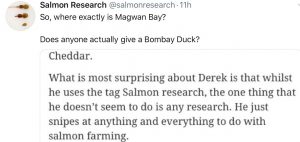
Keyboard warriors like Derek don’t seem to like being questioned, which is why they never respond with real facts and block people who undermine their comments.
Another keyboard warrior is Salmon Social Distancer. Like Derek, his or her twitter name has changed more than once and he has also blocked me. He or she also likes to use other people’s photos because he or she prefers to hide behind a wall of anonymity.
He or she has tweeted with the suggestion that all my views on salmon interactions are based on just one graph.

I admit that I do refer repeatedly to one specific graph. This shows the decline of sea trout catches from 1952 onward. I keep on repeating it because as yet, no-one, including Derek or Salmon Social Distancer have been willing to provide an alternative explanation, other than salmon farming is killing wild sea trout, as to why these catches have declined so much. The point about the graph is that sea trout catches were in decline for around thirty years prior to the establishment of a salmon farming industry. Salmon farms could not be responsible as they didn’t exist.
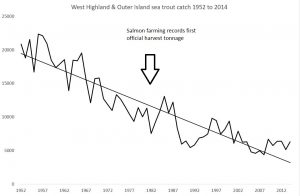
Perhaps, Salmon Social Distancer would like to provide an alternative explanation for sea trout declines rather than continue to blame salmon farming for everything that happens along the Scottish west coast. It shouldn’t be too difficult for these keyboard experts.

